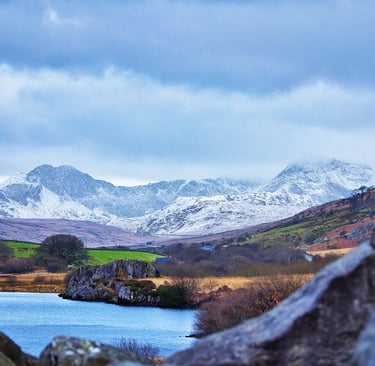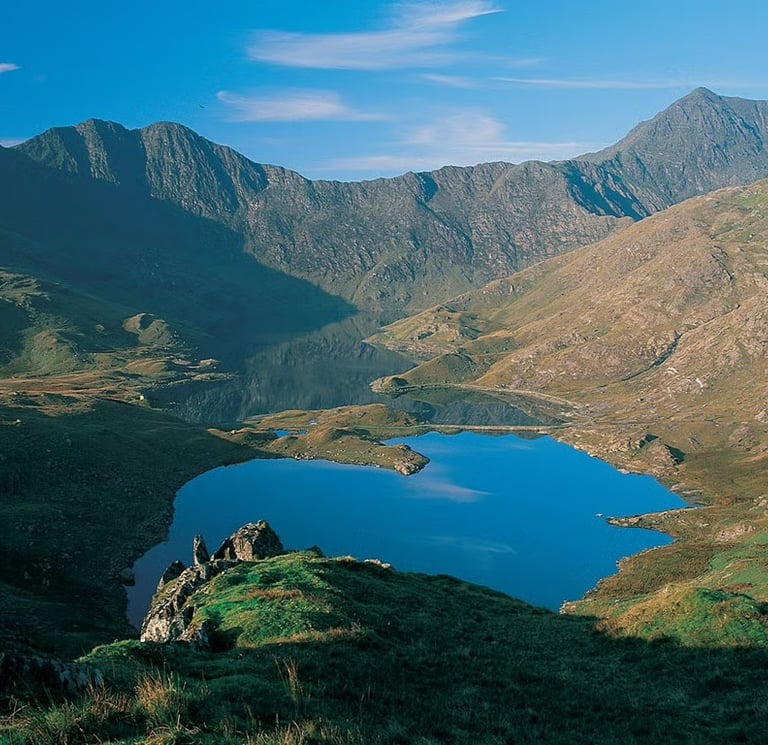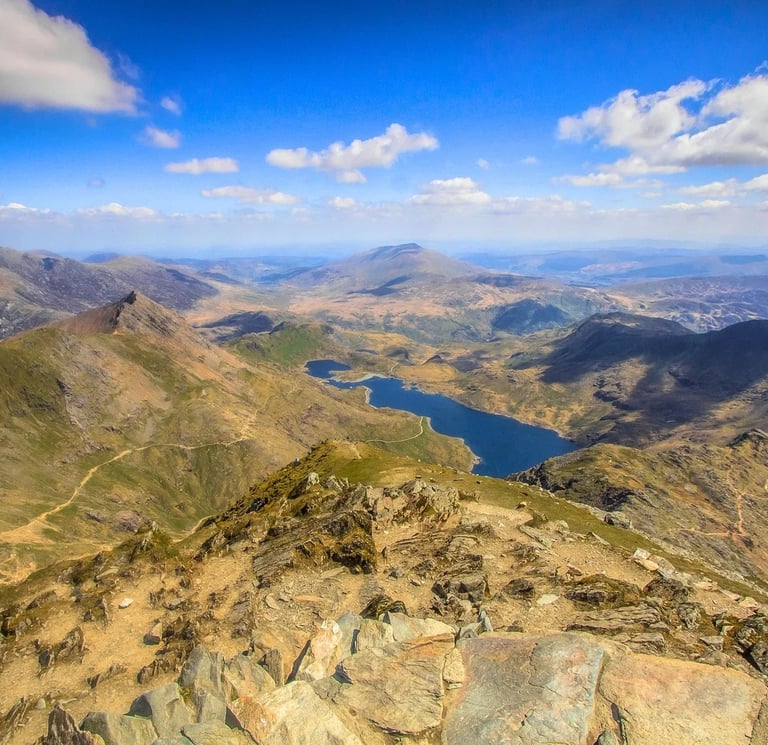Yr Wyddfa - The Welsh Mountain 'Tomb'
PILGRIMAGE UK: HOLY PLACES


High above the undulating valleys of North Wales, Yr Wyddfa (meaning The Tomb, in English), stands as a majestic beacon to those who seek a profound spiritual journey. For centuries, this peak has drawn pilgrims not merely as a physical challenge but as an embodiment of Celtic spirituality—a landscape where God’s creation speaks in the ancient language of nature, tradition, and divine mystery.
In the footsteps of the early Celtic saints, who often found solace amid remote and rugged terrains, pilgrims today ascend Yr Wyddfa with hearts filled with both reverence and longing. The mountain, formed from ancient volcanic and sedimentary rocks and weathered by the ceaseless forces of nature, is a reminder that all of creation bears the imprint of the eternal. As St Augustine once wrote, “Our hearts are restless until they find their rest in thee,” and nowhere is this restless spirit more palpable than on a pilgrimage up Mount Snowdon, where each step upward mirrors the pilgrim’s own journey towards inner peace and divine union.
For the Celtic pilgrim, nature is a liturgy in itself. The early Celtic Church, unburdened by the rigidities of later scholasticism, embraced a spirituality that saw God’s presence woven through every element of the natural world. Walking the ancient paths of Yr Wyddfa, the pilgrim is immersed in this tradition. The wild, unspoilt landscape—with its crisp mountain air, sweeping vistas and the dramatic interplay of light and shadow over its rugged slopes—is not merely a backdrop for contemplation but a sacramental space. Here, the words of St. John Henry Newman resonate deeply: “The proper study of mankind is man,” yet on these ancient paths, one learns that man is integrally part of God’s creation, called to discern the divine in every stone and every ray of sunlight.
The ascent of Yr Wyddfa n is as much a physical exercise as it is a spiritual one. The pilgrimage is marked by challenging climbs, steep slopes and moments of quiet solitude where the pilgrim is invited to surrender to God’s mysterious presence. As the journey unfolds, one cannot help but recall the wisdom of St. Teresa of Avila, who taught, “Let nothing disturb you, let nothing frighten you, all things are passing away: God never changes.” With each strenuous step and every moment of pausing to catch one’s breath, the pilgrim is reminded that God is not only the author of the cosmos but also the healer of weary souls. The physical rigour is transformed into a metaphor for the trials and triumphs of the spiritual life—a daily ascent towards a higher, more profound communion with the Divine.
At the summit of Yr Wyddfa, a panoramic view unfolds that seems to merge the earthly and the eternal. The vast expanse of the Welsh sky unfurls above, while far below, patchworks of glacial valleys, shimmering lakes, and ancient forests form a living tapestry—a testament to the hand of God in nature. In these moments, the pilgrim is struck by the truth, as echoed by Cardinal Newman, that “To live is to change, and to be perfect is to have changed often.” Here on the peak, the ephemeral nature of human life is rendered in contrast to the timeless beauty of creation, inviting the soul to cast aside its temporal chains and embrace the eternal hope inherent in God’s plan.
Yr Wyddfa also occupies a distinctive place within the context of Celtic pilgrimage—a tradition that celebrates the interconnectedness of all creation. The early Celtic saints, such as St. David and St. Columba, often retreated into the solitude of nature, finding in the wild landscapes a profound communion with God. Their spirituality was not confined to the walls of a church, but was an incarnational faith that saw the divine in the rustle of leaves, the murmur of streams and the silent majesty of windswept hills. For the modern pilgrim, this offers a powerful reminder: that the same Spirit who animated the early Celtic monks continues to guide and inspire those who willingly journey into the wild. In the words of the Venerable Bede, “They that have walked the path of the saints set their feet in the light, and serve their Master’s command.” To tread the paths of Mount Snowdon is, thus, to join a continuum of hospitality and devotion that stretches back into the mists of time.
The theological implications of such a pilgrimage are profound. In ascending Yr Wyddfa, the believer is not only overcoming the physical distance between valley and peak, but is, in effect, scaling the heights of spiritual maturity. The journey serves as a living catechism, teaching that the path to God is paved with both struggle and grace. The mountain stands as a symbol of the Church’s enduring teaching on the necessity of ascetic discipline combined with fervent prayer—a theme echoed throughout the Church’s history by such luminaries as St. Benedict, who reposed that “Idleness is the enemy of the soul.” Hence, every sweat-dropped, persevering step is a humble act of worship, a physical manifestation of the inner striving towards God.
Moreover, the pilgrimage to Yr Wyddfa offers a space for reflection on the enduring message of resurrection and hope central to the Catholic faith. As pilgrims gather at the summit or in quiet glens along the way, they may reflect on the eternal words of St. Augustine, who reminds us that “God is always trying to give us new beginnings, but we must first let go of the past.” It is here among the timeless peaks and the ancient skies that the pilgrim can experience a personal renewal, a shedding of old burdens, and the dawning of a life reawakened by the light of God.
In the midst of modern distractions and the relentless pace of contemporary life, Yr Wyddfa remains a sanctuary—a consecrated ground where time slows, and the pilgrim may lose themselves in the beauty of creation and the depth of divine mystery. In its solitude, the mountain calls for a return to simplicity, echoing the primordial prayer of the early Church: a devotion that sought intimacy with God beyond the trappings of material modernity. It is in this quiet communion with the natural world that one discovers that true pilgrimage is not achieved solely by arriving at a destination but by embracing every step of the journey as a sacrament of inner transformation.
The significance of such a sacred quest is further underscored by the rich tapestry of theological teaching and Catholic tradition. Through the ages, the Church has celebrated the importance of pilgrimage as a means of opening the soul to God’s infinite love. Notable Catholics, from St. Francis of Assisi to St. Teresa of Avila, have recognised that the journey itself is a form of prayer—a moving, living liturgy where every landscape becomes a chapter in the story of salvation. In the spiritual ascent of Yr Wyddfa, the faithful are invited to leave behind the chaos of everyday existence and, like the ancient monks of Celtic tradition, enter a realm of quiet majesty where every breath is a prayer and every glance at the sweeping vistas is a glimpse of eternity.
Thus, Yr Wyddfa is not merely a geographical landmark of North Wales; it is a pilgrimage site that encapsulates the very essence of Celtic spirituality. It stands as a testament to the Indigenous wisdom of the early Church, which drew its strength from the natural world and saw in every mountain and valley the loving hand of God. For the pilgrim, the mountain is both a physical destination and a spiritual odyssey—a sanctuary where the echo of ancient saints mingles with the silent rhythm of God’s creation.
The pilgrimage to Yr Wyddfa is a timeless act of faith, one that blends rigorous physical endeavour with the transcendent beauty of Celtic spirituality. As you ascend its challenging paths and absorb the majestic vistas, you are drawn into a living dialogue with history, nature and the divine—a dialogue that has been nurtured by the prayers of generations of saints and nourished by the enduring legacy of a faith that sees God in every element of creation. May this sacred journey renew your spirit, refine your soul and reaffirm your belief that in the eternal heights of the mountain, and in the quiet depths of prayer, one can indeed find rest for a restless heart.
Yr Wyddfa: A Celtic Pilgrimage of Contemplation and Divine Ascent










Ancient Apostolic Catholic Church
Embracing faith, inclusion, and compassionate service together.
ST THOMAS AQUINAS SEMINARY
© 2025. All rights reserved
QUICK LINKS
